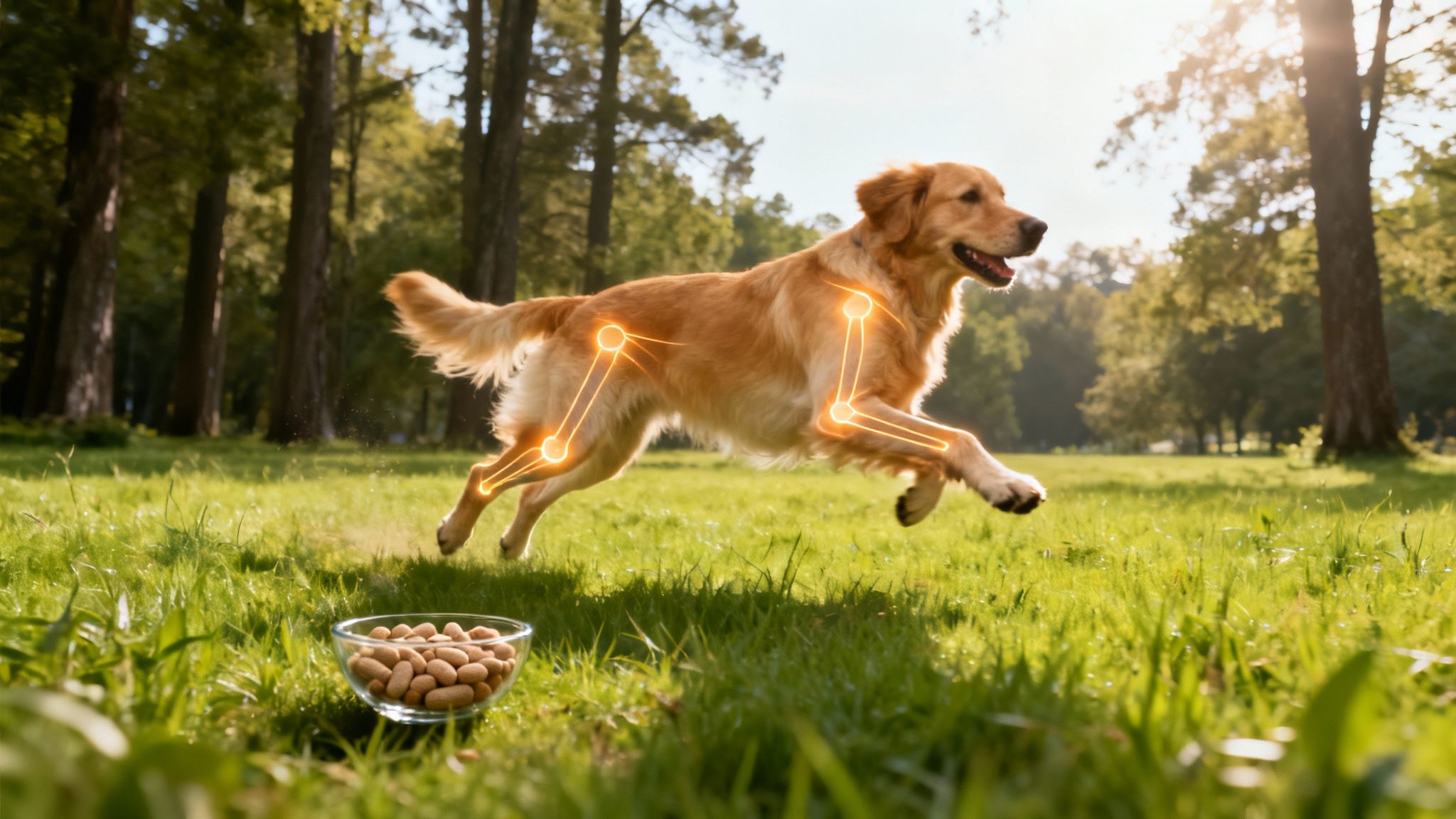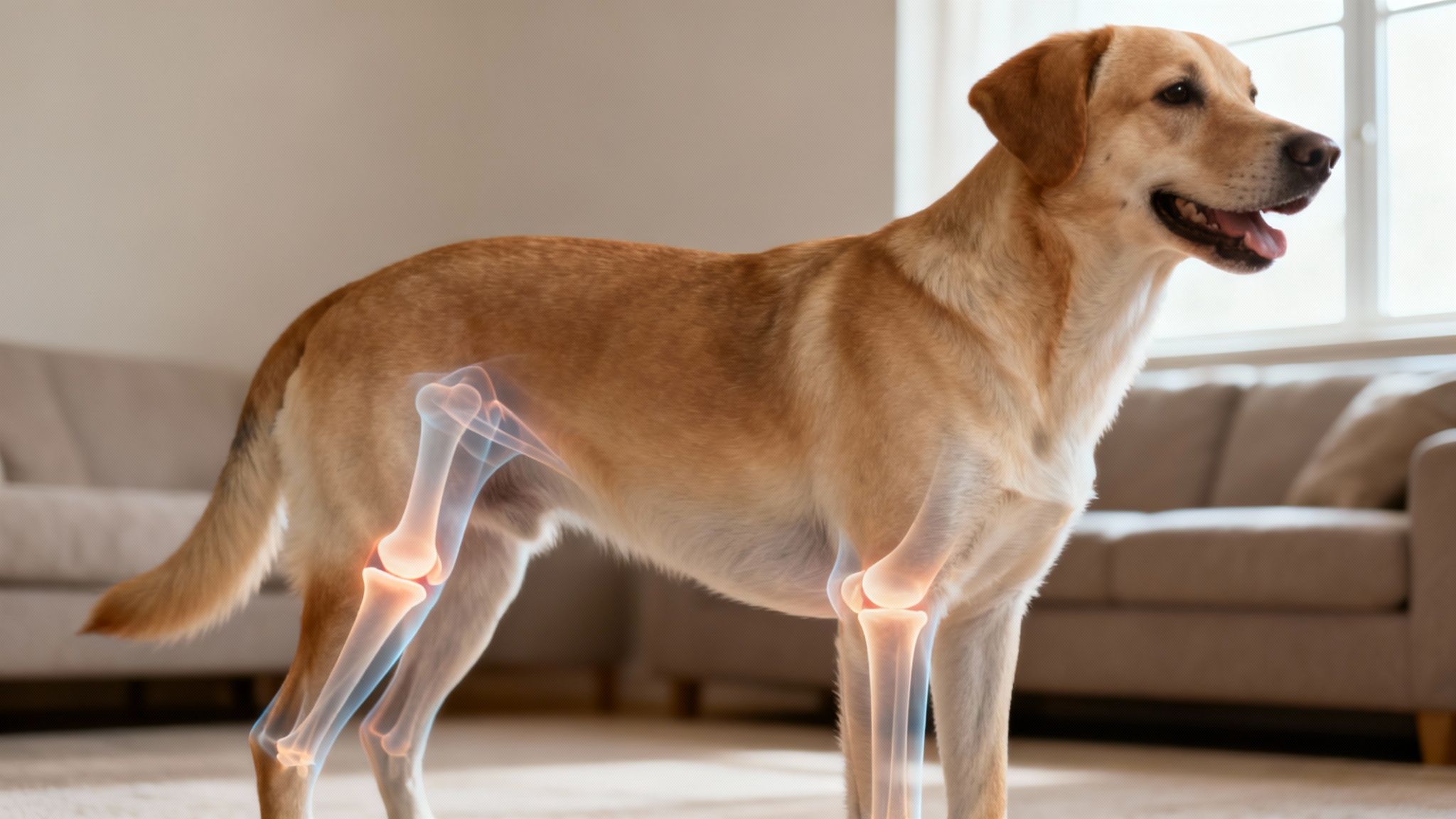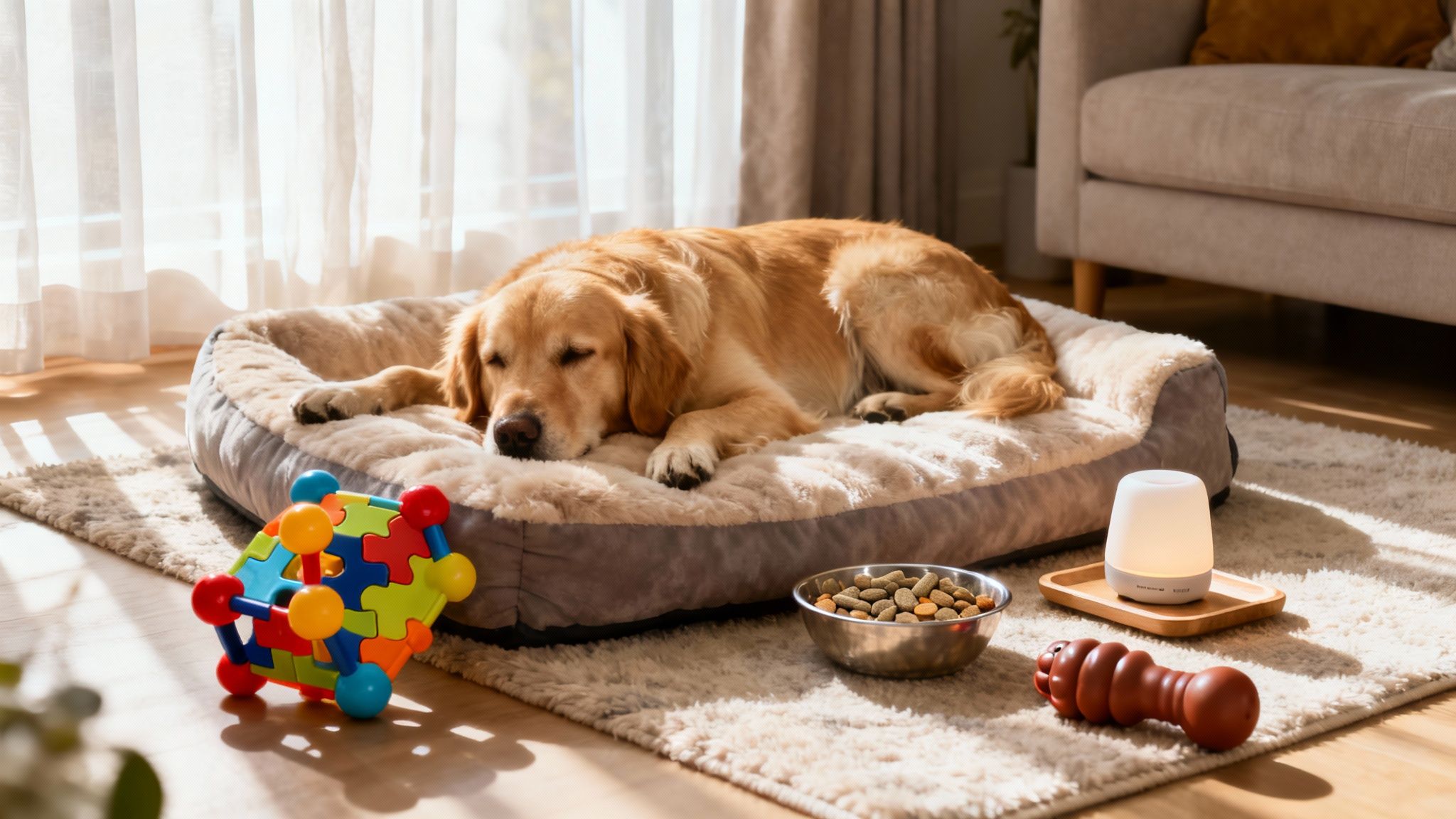A Guide to Dog Joint Health for Happy Pups
Discover the essential guide to dog joint health. Learn to spot early signs, understand treatments, and use simple tips to keep your dog active and pain-free.

When we talk about "dog joint health," we're really just talking about keeping your dog's internal "hinges" working smoothly so they can move without pain. Think about it: when the cartilage and fluid in their joints are in good shape, your dog can run, jump, and play like nothing can stop them. Taking care of those joints from the start is one of the best things you can do for their long-term comfort and happiness.
The Building Blocks of Your Dog's Mobility

At its heart, dog joint health is all about protecting the parts that let them move. Every single time your dog pounces on a toy or dashes up the stairs, a whole system of bones, cartilage, and fluid is working together flawlessly. It’s a pretty amazing system, but it’s also more delicate than you might think. It needs our help to stay in great shape throughout their life.
Let’s break it down. Picture a joint as the meeting point for two bones. The ends of those bones are covered with a smooth, tough, and slightly rubbery material called cartilage. This stuff is a natural shock absorber, and its main job is to stop the bones from painfully grinding against each other. To keep everything gliding, the joint is filled with a thick, slick liquid called synovial fluid. When the cartilage is healthy and there’s plenty of fluid, movement is effortless and pain-free.
Why You Can't Afford to Wait on Joint Care
The problem is, this system can start to break down. The daily grind of aging, a genetic tendency in certain breeds, or even an old injury can wear away at both the cartilage and the lubricating fluid. When that happens, you get friction, inflammation, and pain—the classic signs of joint trouble.
This is exactly why we need to think about joint health long before our dogs become seniors. It’s not just an old-dog issue. Puppies, especially from larger breeds, and very active adult dogs are also at risk. Great joint care is really a four-part strategy:
- Smart Nutrition: Feeding a diet with the right building blocks for strong cartilage.
- Weight Control: Keeping them lean to take unnecessary stress off their joints.
- The Right Kind of Exercise: Building up the muscles that support and stabilize the joints.
- A Joint-Friendly Home: Making small changes to minimize the risk of slips, falls, and injuries.
The bottom line is that being proactive can seriously delay—or even prevent—the start of painful joint conditions. It’s what allows our dogs to stay active and joyful for as long as possible.
And this isn't just a niche concern anymore. The market for dog joint care products was valued at around USD 1.24 billion and is expected to climb to USD 2.28 billion by 2035. That growth is fueled by our pets living longer and by owners like us paying more attention to mobility.
With issues like osteoarthritis impacting roughly 5% of all dogs, knowing how to properly care for their joints is essential. You can learn more about the growing focus on canine joint care to understand why this is such a hot topic. Having this foundational knowledge gives you the power to make choices that will directly shape your dog's well-being for years to come.
Spotting the Early Signs of Joint Discomfort

Dogs are stoic creatures. It’s in their DNA. This instinct to hide pain is a leftover from their days in the wild, but it means that by the time you see an obvious limp, their joint problem might already be well underway. Learning to pick up on the subtle clues is one of the most powerful things you can do for your dog’s long-term comfort.
Think of yourself as a detective for your dog's health. You're not looking for a single smoking gun, but a collection of small changes in their daily life. These little shifts are your dog’s only way of telling you that something just doesn’t feel right.
Catching these quiet signals early allows you to step in sooner, which can make a huge difference in managing dog joint health. An early start can slow down conditions like arthritis and keep your best friend happier and more active for years to come.
Behavioral Clues: What Your Dog's Actions Are Telling You
More often than not, the first signs of joint pain are behavioral, not physical. Your dog will start adjusting their routine to avoid movements that hurt. You might not hear a yelp, but you may notice they’ve quietly stopped doing something they once loved.
For instance, does your dog hesitate before hopping on the couch for a cuddle? Do they pause at the bottom of the stairs, seemingly weighing the decision to climb? That hesitation is a classic telltale sign. It means that a once-effortless movement now requires a bit of mental preparation to brace for discomfort.
A change in mood is another huge clue. A normally sweet dog might suddenly become irritable or withdrawn. They might even get a little snippy when you try to pet them near a sore spot. This isn't a personality flaw; it's a direct response to pain.
Key Takeaway: Any unexplained change in your dog’s normal routine, habits, or personality is a red flag. It’s often their first and clearest way of saying, “I’m hurting.”
Physical and Behavioral Signs to Look For
To be a good health detective, you need to know exactly what evidence to look for. The signs can be incredibly subtle or painfully obvious, but together they build a clear picture of your dog’s comfort level.
Here’s a quick-reference table to help you tune into the specific physical and behavioral clues.
Quick Checklist for Canine Joint Discomfort
This simple checklist can help you identify the common physical and behavioral symptoms that point to potential joint pain in your dog.
Keeping these signs in mind will help you spot trouble before it becomes a major problem. Recognizing these clues is the first and most important step you can take. By catching joint issues early, you and your vet can create a plan to manage discomfort and protect your dog’s quality of life.
Understanding Common Canine Joint Conditions
When your vet throws around words like "osteoarthritis" or "dysplasia," it's easy to feel a knot form in your stomach. These clinical terms can sound intimidating, leaving you worried and unsure what to do next. But getting a handle on what's actually going on inside your dog's joints is the first real step to helping them.
Let's break down these common conditions. Instead of seeing them as scary diagnoses, think of them as specific problems we can manage. Knowing the "what" and "why" behind your dog's joint pain helps you ask the right questions and feel confident in the care plan you build with your vet.
Osteoarthritis: The "Wear-and-Tear" Disease
Osteoarthritis (OA) is, hands down, the most frequent cause of joint pain in dogs. The best way to picture it is to think of the slick, smooth cartilage at the ends of your dog's bones like the tread on a car tire. After years of running, jumping, and chasing balls, that tread simply starts to wear thin.
As the cartilage wears away, the joint loses its natural cushion. The bones, no longer gliding effortlessly, begin to rub against each other. This friction is what leads to inflammation, stiffness, and pain. It's like a well-oiled machine part that’s started to rust—the movement becomes creaky, restricted, and uncomfortable.
This is exactly why vets often call it a "wear-and-tear" disease. While it’s most common in older dogs, it can show up much earlier if triggered by an injury, excess weight, or a developmental issue like dysplasia.
The Big Picture: Osteoarthritis is progressive, meaning it gets worse over time. Our goal isn't to turn back the clock and reverse the damage, but to hit the brakes on its progression, control the pain, and keep our dogs happy and comfortable for as long as possible.
This isn't a rare problem. In fact, experts estimate that about 20% of all dogs will deal with joint issues at some point. The sad part is, many cases are missed because we mistake the early signs—like slowing down a bit on walks—as just a normal part of getting older. The American Animal Hospital Association (AAHA) explains why catching these changes early is so critical.
Hip Dysplasia: A Problem of Poor Fit
Unlike arthritis, which is about the cartilage breaking down over time, hip dysplasia is a developmental issue. It starts when a dog is just a puppy and happens because the hip joint—a classic ball-and-socket—doesn't form properly. The "ball" at the top of the thigh bone is too loose and doesn't sit snugly in the hip "socket."
Because of this poor fit, the whole joint is unstable. With every step, instead of rotating smoothly, the ball rattles around in the socket. This constant, abnormal movement puts a huge amount of stress on the joint.
- The Root Cause: The joint is mechanically wobbly from a young age.
- The Result: Over time, that constant friction and instability causes inflammation, pain, and eventually, a bad case of osteoarthritis in the hip.
This is largely a genetic issue, which is why we see it so often in certain breeds like German Shepherds, Labradors, and Golden Retrievers. If you have one of these dogs, one of the most powerful things you can do is keep them at a healthy, lean weight right from puppyhood.
Elbow Dysplasia: A More Complicated Forelimb Issue
Elbow dysplasia is a lot like hip dysplasia, but it affects the front legs. The elbow is a trickier joint—it’s where three different bones have to meet and work together perfectly. So, "elbow dysplasia" is really an umbrella term for several different inherited problems that mess up that perfect fit.
Any of these developmental flaws can cause the joint to be misaligned. Just like with the hip, this bad fit leads to chronic rubbing, damage to the cartilage, and ultimately, painful arthritis. The signs often pop up when a dog is still quite young, sometimes as early as 5 to 8 months old.
We see this most often in large and giant breeds, like Bernese Mountain Dogs, Rottweilers, and Newfoundlands. If you have one of these breeds, it's so important to watch for subtle signs like a limp in a front leg or stiffness after they’ve been lying down for a while. Catching it early makes all the difference.
How Vets Diagnose and Treat Joint Issues
If you suspect your dog is dealing with joint pain, the single most important thing you can do is call your veterinarian. That appointment is where your real-world observations meet their clinical expertise, giving you both a complete picture of what's going on.
Think of the diagnostic process like a puzzle. Your vet is a detective, piecing together clues from your dog's history, a hands-on exam, and sometimes imaging to get to the root of the problem.
The Initial Physical Examination
The first step is almost always a thorough physical exam. Your vet will gently move your dog’s limbs, checking the range of motion in each joint. They're feeling for any subtle signs of pain, swelling, or heat.
They’re also listening for a crackling sensation known as crepitus, a telltale sign that cartilage might be damaged.
Next, they'll watch how your dog walks, what vets call their gait. Seeing your dog move around the room helps them spot a slight limp or stiff movement that’s easy to miss at home. This simple gait analysis is a powerful tool for zeroing in on which joint is causing the trouble.
Using Imaging to See Inside the Joint
If the physical exam points to a problem, your vet will likely recommend imaging to see what’s happening beneath the surface. This is often where the true cause of the pain is finally revealed.
The go-to imaging tool is the X-ray (radiograph). X-rays do a great job of showing changes in the bones themselves, like the rough edges you see with arthritis or the poor fit of a dysplastic hip. For more complicated cases, a CT scan might be suggested for a detailed, 3D view of the bone structure.
This visual shows how vets can pinpoint three common joint issues that cause discomfort.
Seeing the difference between inflammation in osteoarthritis and the structural problems of dysplasia makes it clear why getting the right diagnosis is so crucial for treatment.
Medical Treatments for Pain and Inflammation
Once there's a clear diagnosis, your vet will craft a treatment plan just for your dog, considering their specific condition, age, and overall health. The main goals are always to manage pain, dial down inflammation, and get them moving more comfortably.
The foundation of medical treatment is often a class of drugs called Non-Steroidal Anti-Inflammatory Drugs (NSAIDs). These are made specifically for dogs (you should never give your dog human NSAIDs) and work wonders for reducing the pain and swelling that come with arthritis.
Important Note: While NSAIDs provide amazing relief, they are just one piece of the puzzle. The most effective plans combine medication with other therapies to support your dog's joint health for the long haul.
Other medical options your vet might bring up include:
- Corticosteroid Injections: For a bad flare-up, a vet might inject a steroid directly into the painful joint. This offers powerful, targeted relief but is typically a short-term solution.
- Pain-Relieving Medications: Sometimes, NSAIDs aren't enough. Other drugs that target nerve pain, like gabapentin or tramadol, can be added to help manage chronic discomfort.
- Disease-Modifying Drugs: Certain injectables, like polysulfated glycosaminoglycan (PSGAG), work to protect cartilage and improve the quality of joint fluid, helping to slow down arthritis.
Surgical Options for Severe Cases
For some dogs, medication alone won't cut it. This is often the case with severe hip or elbow dysplasia or a major ligament tear. When that happens, surgery might be the best path forward to restore function and get rid of the pain for good.
Surgery is a big step, but for the right dog, it can be completely life-changing. Common options include:
- Femoral Head Ostectomy (FHO): A procedure for severe hip dysplasia where the "ball" of the ball-and-socket joint is removed. Scar tissue forms a "false joint," which can dramatically reduce the pain of bone grinding on bone.
- Total Hip Replacement (THR): Just like the human version, this surgery replaces the entire worn-out hip joint with prosthetic parts. It's often considered the gold standard for getting a dog back to normal, pain-free activity.
- Arthroscopic Surgery: This is a minimally invasive "keyhole" surgery. A tiny camera is used to go into a joint like an elbow or shoulder to clean out bone fragments and smooth damaged cartilage.
Your veterinarian is your most trusted partner in this journey. By working together, you can build a complete plan that not only eases your dog's immediate pain but also supports their mobility and happiness for years to come.
How Diet and Supplements Can Support Your Dog's Joints
What your dog eats has a massive impact on their ability to get around comfortably. Think of it this way: you can’t build a strong house with flimsy materials. The same goes for your dog’s body—proper nutrition provides the essential building blocks for healthy, resilient joints. A smart approach to their diet, sometimes boosted with the right supplements, can help keep inflammation in check, protect precious cartilage, and genuinely improve their quality of life.
It all starts with one incredibly important idea: managing their weight.
Try to imagine carrying a heavy backpack everywhere you go, every single day. That's exactly what excess weight does to your dog’s joints. It’s a constant, grinding stress that speeds up the wear and tear on their cartilage.
Seriously, keeping your dog at a lean, healthy weight is the single most powerful thing you can do for their dog joint health. Even losing just a few pounds can make a world of difference for an overweight dog, often leading to a visible improvement in their movement and a big drop in their pain levels.
What Do Joint Supplements Actually Do?
Beyond keeping your dog lean, certain supplements can give their joints some much-needed backup. They aren't a magic fix, but they are fantastic allies in the fight against joint breakdown and stiffness, especially for dogs who are genetically prone to problems or are already showing their age.
You can think of these supplements as a dedicated repair crew for your dog’s joints. They show up with the raw materials needed to patch things up and reinforce the whole structure. The most common and well-researched ingredients you'll see are:
- Glucosamine: This is a natural compound that’s a core building block of cartilage. Adding it to your dog’s diet helps ensure their body has plenty of material on hand to repair and maintain that crucial joint cushion.
- Chondroitin Sulfate: Often paired with glucosamine for a one-two punch, chondroitin helps cartilage hang onto water, which is key to its shock-absorbing ability. It also helps block certain enzymes that are notorious for breaking down cartilage.
- Omega-3 Fatty Acids: Found in things like fish oil and green-lipped mussels, these healthy fats (specifically EPA and DHA) are nature’s anti-inflammatories. They work to cool down the painful inflammation inside the joint that makes conditions like arthritis so miserable.
A proactive plan that includes a healthy diet and the right supplements can completely change the course of joint disease. You're giving your dog's body the tools it needs to defend itself, reduce inflammation, and stay mobile for the long haul.
How to Read a Supplement Label
Walking down the supplement aisle can feel overwhelming, but a few simple tips can help you pick a good product. It’s not just about what’s listed on the front; it’s about the quality of those ingredients and how transparent the company is.
When you're checking out a supplement, look for these signs of a quality product:
- Clear Ingredient Sourcing: The label should be upfront about where the active ingredients come from. For example, is the fish oil from small, wild-caught fish to minimize the risk of contaminants?
- Third-Party Testing: The best brands voluntarily send their products to an independent lab to confirm they contain what they say they do, and nothing else. Look for seals from trusted groups like the National Animal Supplement Council (NASC).
- No Junk Fillers: A good supplement won't be packed with artificial colors, mystery flavors, or preservatives that do nothing for your dog’s health. The ingredient list should be focused on what works.
It's no surprise that these supplements are more popular than ever as dog owners get smarter about preventative care. Data from the massive Dog Aging Project, which tracks over 27,500 dogs, shows a clear connection between a dog's age, breed, and their owner's decision to use joint supplements. The rising use of glucosamine, chondroitin, and omega-3s reflects a huge shift in owner awareness of dog joint health—a trend that’s expected to grow the market to almost USD 2 billion by 2035. If you want to dive deeper, you can explore the research behind supplement use in dogs to see what the science says. A little bit of knowledge here can help you make a great choice for your best friend.
Creating a Joint-Friendly Home Environment

Managing your dog’s joint health goes way beyond just supplements and trips to the vet. Your home itself can either be a daily obstacle course that makes their pain worse or a safe, comfortable space that supports their mobility. A few simple, thoughtful changes can make a world of difference, dramatically reducing the daily strain on their joints.
Think about what a single jump off the couch feels like. For a dog with sore hips or stiff elbows, that landing sends a painful jolt right through their body. Over time, all those little impacts add up, speeding up the wear and tear on their joints. The goal is to make their environment as low-impact as possible.
This is a huge part of proactive dog joint health, helping you manage their current condition and prevent future injuries.
Building a Foundation of Comfort and Safety
Start by looking at your home from your dog's point of view, especially the floors and furniture. Slippery surfaces like hardwood, tile, or laminate can feel like walking on an ice rink for a dog who's already a bit wobbly. Their muscles have to work overtime just to stay upright, which puts a ton of stress on their joints.
This is where you can see a huge impact from small changes. Placing non-slip rugs and runners in high-traffic areas—like the path from their bed to the water bowl—provides the grip they need to walk confidently.
Modifying your home actively removes the daily physical stressors that lead to joint pain. It’s one of the kindest and most effective ways to improve their quality of life, requiring no extra effort from them.
Another game-changer is their bed. Just like a good mattress is crucial for our backs, an orthopedic dog bed gives aching joints the support they crave. These beds are made with high-density foam that molds to their body, cushioning pressure points and helping them maintain a comfortable alignment while they sleep.
Eliminating High-Impact Movements
Jumping on and off furniture is one of the toughest things for a dog's joints. You can get rid of this strain almost entirely by adding ramps or pet stairs to their favorite spots.
- For the Couch or Bed: A well-placed ramp turns a jarring leap into a gentle, pain-free stroll up to their favorite napping spot.
- For the Car: Getting into a car can be a real struggle. A portable ramp makes trips to the vet or the park so much easier on their body.
Elevated food and water bowls can also offer a surprising amount of relief. If your dog has neck or back stiffness, bending down to eat and drink can be painful. Raising their bowls to about chest height takes that strain away and makes mealtime more enjoyable.
Finally, think about how they play. While exercise is essential, high-impact activities like launching after a ball again and again can do more harm than good. Shift your focus to low-impact exercises that build muscle without pounding the joints. Gentle walks on soft surfaces like grass or—the gold standard—swimming are fantastic for keeping them strong and flexible. These adjustments create a home where your dog can move with comfort, confidence, and a lot less pain.
Your Top Questions About Dog Joint Health
When it comes to your dog's joint health, it's natural to have questions. Let's walk through some of the most common concerns I hear from dog owners, so you can feel more confident about keeping your best friend comfortable and active.
When Should I Start Thinking About My Dog's Joints?
Honestly? The best time to start is right now, no matter how old your dog is.
Think of it like this: dog joint health is something you build over a lifetime. For puppies, especially large breeds predisposed to issues like hip dysplasia, this means starting on day one. A proper diet and preventing them from overdoing it on their still-developing joints lays the groundwork for a healthy future.
With adult dogs, the game plan shifts slightly to maintenance—keeping them at a healthy weight and ensuring they get regular, low-impact exercise. The old saying holds true: prevention is always better than cure.
Can My Dog Still Exercise with Arthritis?
Yes, absolutely! In fact, you should keep them moving. Gentle exercise is one of the most beneficial things you can do for a dog with arthritis.
Movement keeps the joints lubricated and the supporting muscles strong. The trick is to swap out high-impact, jarring activities for things that are a bit kinder on their body.
- Instead of endless games of fetch, try shorter, gentle leash walks on soft ground like grass or a trail.
- Swimming is a fantastic option. It's a non-weight-bearing exercise that builds muscle without stressing the joints.
Of course, always have a chat with your vet first. They can help you create a plan that keeps your dog feeling good without pushing them past their limits.
Do Joint Supplements Actually Work?
This is a big one. The short answer is yes, many of them can make a real difference. High-quality supplements with ingredients like glucosamine, chondroitin, and omega-3 fatty acids have been shown to support cartilage health and reduce inflammation.
They aren't a magic cure, but they can be an incredibly powerful tool for managing discomfort and slowing down the progression of joint disease.
Before you start any supplement, it's crucial to talk to your veterinarian. They can point you toward a product from a reputable brand and make sure it’s the right fit for your dog's specific situation, helping you make a smart investment in their long-term comfort.
Join thousands of pet parents getting science-backed health insights and natural care advice


